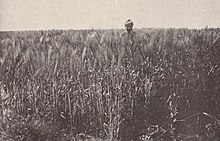
The Chaouia (Arabic: الشاوية, romanized: shāwiyya) is a historical and ethno-geographical region of Morocco. It is bounded by the Oum er-Rbi' River to its southwest, the Cherrate River to its northeast, the plain of Tadla to the southeast and the Atlantic Ocean to the northwest. The region covers a land area of nearly 14 000 km. The term also refers to a tribal confederation that traditionally inhabits the region.
Etymology
The word "Chaouia" means "Land of Chaouis". "Chaoui" is a word meaning "possessors of sheep" or "shepherds".
Geography
Geographically, the Chaouia can be divided into two sub-regions: low and high. The low Chaouia being the coastal part while the high Chaouia is further inland. Soils vary in fertility: The dark tirs is prized for its high yields and is found among the Mdhakra, Ouled Hriz and Oulad said. There is also the red hamri terra rossa.
Throughout Morocco's history, the Chaouia was famous for farming wheat and barley, which were exported in years of abundance from Casablanca, Fédala or Azemmour. Chaouia sheep was also prized for its wool, which was also exported to Marseille where it was known as wardigha in reference to one of the tribes in the interior.
Nowadays, the Chaouia is part of the Casablanca-Settat administrative region.
History
Originally, the Chaouia was ruled by the Barghawata until it was unified to Morocco by the Almoravids, depopulating the area. After the Almohad ruler Abd al-Mu'min captured the town of Marrakesh in 1147, he encouraged the settlement of Bedouin Arab tribes in the area and the rest of the Moroccan coastal plains which were largely depopulated after the Almoravid conquest, including Banu Hilal, Banu Sulaym, and Banu Ma'qil, which led to a further extension of Arabic and an increased importance of Arab elements in the power equation of Morocco, to the point where no one could have ruled there without their co-operation.
In the early 20th century, the Chaouia carried out a strong rebellion against the French. In 1907, the French bombarded Casablanca and entered the Chaouia region before extending their control over all of Morocco. During the French protectorate, the Chaouia was part of the "Autonomous subdivision of Casablanca". It was then divided into three civilians controls : Chaouia-North (Casablanca), Chaouia-Center (Berrechid) and Chaouia-South (Settat).

Tribal composition
The Chaouia (or Shawiya) tribes come from a variety of Arab and Berber origins, although today they are linguistically Arabized. A French survey of Moroccan tribes published in 1915 reported that all of these tribes claimed a pure Arab origin. The Chaouia tribal confederation traditionally consists of 14 Arabic-speaking tribes:
| Tribe | Origin | Notes |
|---|---|---|
| Achach | Arab (Banu Sulaym) | |
| Beni Meskin | Arab | Previously part of the Tadla confederacy, joined the Chaouia in the 19th century. |
| Mdakra | Arab (Ahlaf and Sabbah) and Berber (Hawwara) | Merged with a Barghawata original group. |
| Mediouna | Berber (Zenata) | |
| Mzab | Berber (Zenata) | |
| Mzamza | Mainly Berber (Masmuda) origin, with some later Arab (Zughba) elements | |
| Oulad Ali | Arab (Banu Ma'qil) | |
| Oulad Bouziri | Berber (Sanhaja) | |
| Oulad Hriz | Mainly Arab with Berber origins, due to subtribes | |
| Oulad Saïd | Arab (Zughba, Banu Hilal) | Settled in the region during the Marinid era |
| Oulad Sidi Bendaoud | Mainly Berber (Sanhaja) | |
| Oulad Zyan | Arab (Zughba, Banu Hilal) | |
| Zenata | Berber (Zenata) | |
| Zyayda | Arab |
References
- « Ce terme pluriel "Chaoui", signifie possesseurs de troupeaux de moutons. A l'origine, il servait vraisemblablement à désigner les Berbères nomades et tant que l'on tint compte de son étymologie – ainsi que semble l'avoir fait Ibn Khaldoun – le nom de Chaouia ne paraît pas avoir été donné indistinctement à toutes les tribus du Tamesna, mais seulement à celles purement pastorales des steppes de l'intérieur auxquelles il s'appliquait mieux qu'à la population déjà en partie agricole de la plaine littorale. Par la suite, ce qualificatif devint un véritable nom ethnique et sa signification première tomba dans l'oubli » - F. Weisberger (1935), via M. Belmir, Le Dr F. Weisgerber sur les pistes des Chaouia, dans liberation.ma (1st Oct. 2014)
- Fosset, Robert. "CHAOUÏA". Encyclopædia Universalis. Retrieved 2023-05-07.
- J.F. Troin & M. Berriane, Les espaces satellites de Casablanca : Chaouia et Doukkala, in Maroc : régions, pays, territoires, 2002, pp.71-86 (ISBN 2-7068-1630-9)
- E. Lapeyre & E. Marchand, Casablanca, la Chaouia, 1918 (N. 2 43-120-3)
- S. Lévy, Pour une histoire linguistique du Maroc, in Peuplement et arabisation au Maghreb occidental: dialectologie et histoire, 1998, pp.11-26 (ISBN 84-86839-85-8)
- ^ Isichei, Elizabeth (1997-04-13). A History of African Societies to 1870. Cambridge University Press. p. 190. ISBN 978-0-521-45599-2.
- Fauvel, Jean-Jacques (1978). Le Guide bleu du Maroc (in French). Paris: Hachette Tourisme. p. 302.
- Fage, J. D.; Oliver, Roland Anthony (1975). The Cambridge History of Africa: From c. 500 B.C. to A.D. 1050. Cambridge University Press. p. 360. ISBN 978-0-521-20981-6.
- E. Burke, Mouvements sociaux et mouvements de résistance au Maroc: la grande siba de la Chaouia (1903-1907), dans Hesperis Tamuda Rabat, vol.17, 1976, pp.149-163
- J. Augarde, Le général d'Amade pacificateur de la Chaouia, in Revue historique de l'armée, n°166, 1987, pp.24-32 (ISSN 0035-3299)
- ^ Hart, David M. (2014). Tribe and Society in Rural Morocco. Routledge. pp. 27–28. ISBN 9781135302542.
- ^ Mission Scientifique du Maroc (coll.), Villes et Tribus du Maroc: Casablanca et les Chaouïa, Tome II, Ed. E. Leroux (Paris), 1915
Bibliography
- F. Weisberger, Casablanca et les Chaouia en 1900, Ed. Impr. Réunies (Casablanca), 1935
- E. Marchand, Casablanca, la Chaouia, Ed. Larose (Paris), 1918
| Berber tribes of Morocco | |
|---|---|
| Tribal confederation | |
| Tribes | |